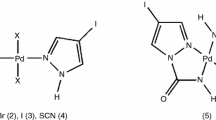Abstract
The nature, products, and enthalpy of the thermal decomposition of [Pd(CH3CO2)2]3 were determined in air, nitrogen and vacuum. Thermogravimetry, differential thermal analysis, evolved gas analysis, differential scanning calorimetry, and infrared spectroscopy were used to characterize the process and products. In vacuum the trimer volatilizes completely below 200 °C. The IR spectrum of the gas phase species is reported. At atmospheric pressure the material decomposed to Pd between 200 and 300 °C depending upon the rate of heating. The apparent activation energy for this process is about 115 ± 5 kJ mol−1 and the enthalpy is 440 ± 20 kJ mol−1. In the presence of oxygen, however, oxidation of the ligands leads to an overall exothermic process. The resulting the Pd then slowly oxidizes to PdO2 up to the decomposition temperature of the oxide near 800 °C. There is the slight loss of a Pd containing species, presumably due to sublimation or gas entrainment, during the decomposition below 300 °C. The extent of this loss increases with increasing heating rate, approaching 10% of the total Pd at heating rates of 64 °C min−1.
Zusammenfassung
Natur, Produkte und Enthalpie der thermischen Zersetzung von [Pd(CH3CO2)2]3 in Luft, Stickstoff und Vakuum wurden untersucht. Zur Charakterisierung des Prozesses und der Produkte wurden TG, DTA, EGA, DSC und IR-Spektroskopie herangezogen. Im Vakuum verflüchtigt sich das Trimere vollständig unterhalb 200°. Das IR-Spectrum der gasförmigen Species ist angegeben. Bei Atmosphärendruck zersetzt sich das Material, abhängig von der Aufheizgeschwindigkeit, zwischen 200 und 300° zu Pd. Die scheinbare Aktivierungsenergie für diesen Prozeß beträgt 115 ± 5 kJ · mol− 1, die Enthalpie beläuft sich auf 440 ± 20 kj · mol−1. In Gegenwart von Sauerstoff werden die gasförmigen Produkte sofort oxydiert, was ein exothermen Bruttoeffekt zur Folge hat. In Gegenwart von Sauerstoff wird Pd langsam bis zur Zersetzung des Oxids bei nahe 800° oxydiert. Es wird ein geringer Verlust einer Pd enthaltenden Species beobachtet, der vermutlich auf Sublimation oder auf Mitreißen im Gasstrom während der Zersetzung unterhalb 300° zurückzüfuhren ist. Dieser Verlust wird mit der Erhöhung der Aufheizgeschwindigkeit größer und erreicht bei einer Aufheizgeschwindigkeit von 64° · min−1 10% des Gesamt-Pd.
Резюме
В атмосфере воздуха, а зота и в вакууме изуче н характер термическо го разложения ацетата палладия [Pd(CH3CO2)2]3, а также определе ны продукты разложения и энтальпия реакции. Процесс разл ожения и идентификац ия образующихся продук тов были проведены с помощью ТГ, ДТА, АВГ, ДСК и ИК спектроскопии. В в акууме тример ацетата палла дия полностью улетучива ется при температуре ниже 200°. Приведен ИК спектр га зообразных частиц. При атмосферн ом давлении вещество разлагается до палла дия между 200 ип 300° в зависимости от скоро сти нагрева. Кажущаяс я энергия активации процесса р азложения составляет около 155±5 кд ж · моль−1, а энтальпия −440±20 кдж · моль−1. Однако, в прис утствии кислорода газообраз ные продукты сразу же окисляются, приводя тем самым к по лностью экзотермическому пр оцессу. В присутствии кислорода палладий медленно ок исляется вплоть до температуры разложе ния окисла около 800°. Во время разложения ацетата п алладия ниже 300° происходила небольш ая потеря палладия, чт о, повидимому, обусловл ено сублимацией его и ли же уносом газом. Степе нь потери увеличивал ась при увеличении скорости нагрева и составляла 10% общего количества па лладия при скорости н агрева 64° в минуту.
Similar content being viewed by others
References
M. E. Gross, J. Appl. Phys., (1986) in press.
P. K. Gallagher, Thermochim. Acta, 82 (1984) 325.
P. K. Gallagher, Thermochim. Acta, 90 (1985) 115.
H. E. Kissenger, Anal. Chem. 29 (1957) 1702.
T. Ozawa, J. Thermal Anal., 2 (1970) 301.
H. Schäfer, C. Brendel, H. Rabeneck and E. Schibilla, Z. Anorg. Allg. Chem., 518 (1984) 168.
J. Cornejo, Afinidad, 38 (1981) 525.
M. D. Judd, B. A. Plunkett, M. I. Pope, J. Thermal Anal., 6 (1974) 555.
R. Hultgren, P. D. Desai, D. T. Hawkins, M. Gleisner, K. K. Kelly, D. D. Wagman, “Selected Values of the Thermodynamic Properties of the Elements,” 1973.
Author information
Authors and Affiliations
Rights and permissions
About this article
Cite this article
Gallagher, P.K., Gross, M.E. The thermal decomposition of palladium acetate. Journal of Thermal Analysis 31, 1231–1241 (1986). https://doi.org/10.1007/BF01914636
Received:
Revised:
Issue Date:
DOI: https://doi.org/10.1007/BF01914636



